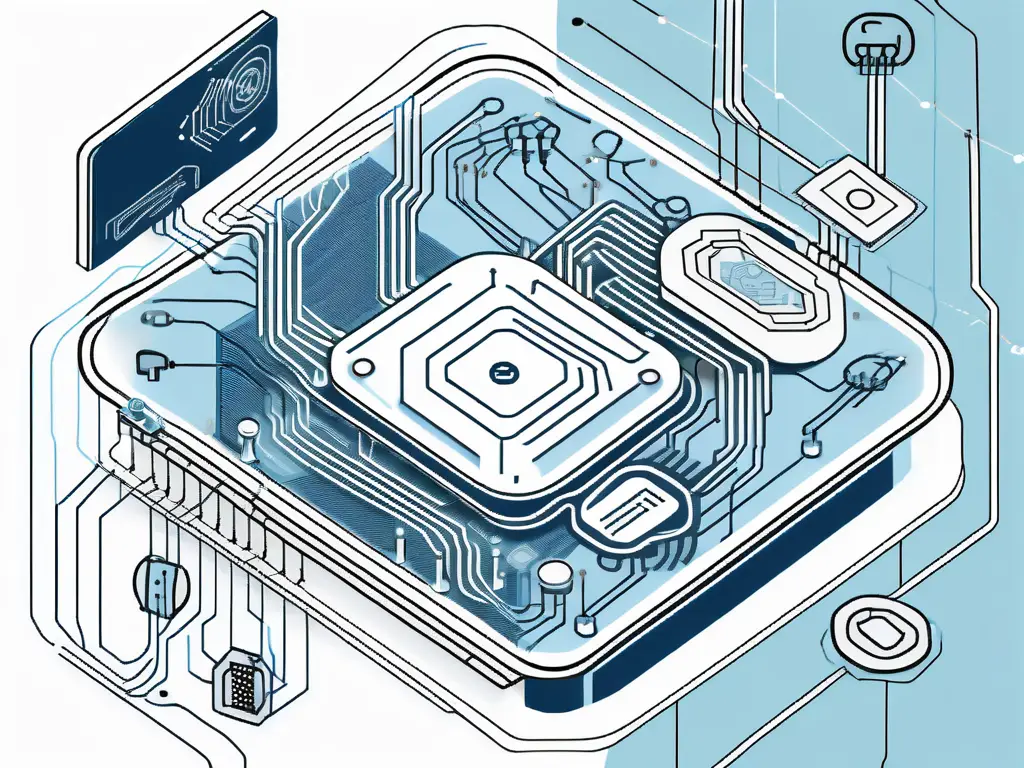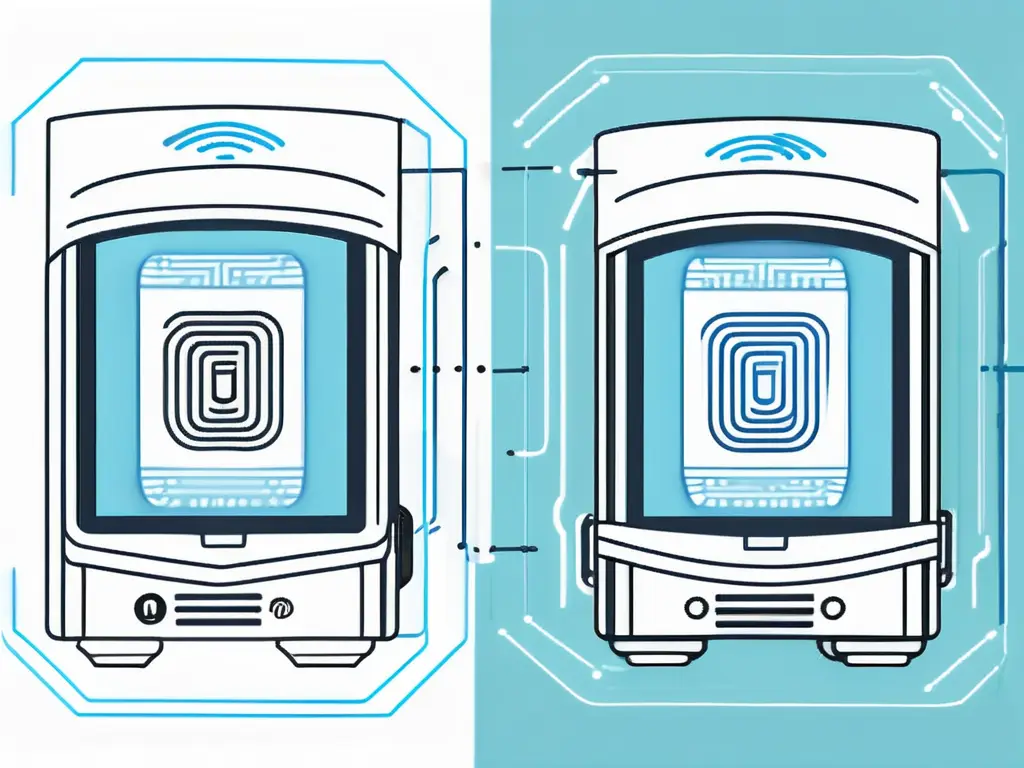In a rapidly advancing world, NFC (Near-Field Communication) and RFID (Radio Frequency Identification) have become essential tools for seamless communication and convenient access. However, with this convenience comes the concern for security. Which is more secure: NFC or RFID? Let’s delve into the basics, explore the technology behind them, compare their security features, weigh the pros and cons, discuss emerging trends, and consider the factors when choosing between them.
Understanding the Basics of NFC and RFID
What is NFC?
NFC, or Near Field Communication, is a wireless communication technology that allows devices to exchange data when they are close to each other. It operates within a short range, typically a few centimeters, and requires both an active initiator and a passive target. This technology is commonly used in contactless payments, electronic ticketing, and access control systems.

NFC technology is based on communication protocols that enable two devices to establish a connection by bringing them close together. This close proximity requirement adds a layer of security, making NFC transactions less susceptible to interception. In addition to its applications in payment systems, NFC is also utilized to share files between smartphones, pair Bluetooth devices, and trigger location-based actions.
What is RFID?
RFID, or Radio Frequency Identification, is a technology that uses electromagnetic fields to identify and track objects equipped with RFID tags. These tags contain electronically stored information that RFID readers can read remotely. RFID technology is widely used in supply chain management, asset tracking, and inventory control.
RFID tags come in various forms, including passive, active, and battery-assisted passive tags. Passive RFID tags do not have an internal power source and rely on the electromagnetic energy transmitted by RFID readers to power the tag and transmit data. Active RFID tags, on the other hand, have their own power source, allowing them to transmit signals over longer distances and store more information. The versatility of RFID technology extends beyond inventory management to applications in tracking livestock, managing library books, and even enhancing amusement park experiences.
The Technology Behind NFC and RFID
How Does NFC Work?
NFC operates on the principles of electromagnetic induction and radio frequency identification. Using an electromagnetic field, NFC-enabled devices can communicate with each other by creating a virtual link. This communication occurs at a high frequency of 13.56 MHz, providing a fast and secure method for data exchange.

NFC technology has revolutionized the way we interact with our devices. From contactless payments to keyless entry systems, NFC has enabled smartphones, tablets, and other gadgets to seamlessly connect and share information with just a tap or a wave. This technology is convenient and secure, as NFC transactions are encrypted to protect user data from potential threats.
How Does RFID Work?
RFID relies on radio waves to transfer data between RFID tags and readers. When an RFID reader emits radio waves, the RFID tag absorbs the energy and uses it to power the chip inside the tag. The chip then transmits the stored information back to the reader, allowing for seamless and efficient tracking and identification of objects.
RFID technology has found widespread applications in various industries, including retail, logistics, and healthcare. By utilizing RFID tags, businesses can improve inventory management, enhance security measures, and streamline operations. RFID tags enable retailers to track products in real-time, reducing stockouts and improving overall customer satisfaction. Similarly, RFID technology helps hospitals and clinics manage medical equipment and track patient records efficiently, ultimately leading to better patient care and safety.
Comparing the Security Features of NFC and RFID
Security Measures in NFC
NFC incorporates several security measures to protect user data and prevent unauthorized access. One key feature is mutual authentication, where both the initiator and the target verify each other’s identities before exchanging data. Additionally, NFC supports secure element technology, which stores sensitive data securely and protects it from unauthorized access.
NFC technology utilizes tamper detection and response mechanisms to detect any unauthorized attempts to access or manipulate the data. In a security breach, NFC devices can be programmed to disable certain functions or wipe sensitive information to prevent further unauthorized access. This proactive approach enhances the overall security of NFC-enabled systems and instills confidence in users regarding protecting their data.
Security Measures in RFID
RFID also employs various security measures to safeguard information. Encryption algorithms secure data transmission, making it difficult for unauthorized parties to intercept and decipher the information. Access control mechanisms, such as passwords and authentication protocols, can also be implemented to ensure that only authorized individuals can access the RFID system.
RFID systems often incorporate anti-collision technology to prevent data interference when multiple RFID tags are in close proximity. This technology enables efficient data transmission and reception, reducing the risk of data corruption or unauthorized access. By implementing encryption, access control, and anti-collision measures, RFID systems can enhance data security and protect sensitive information from potential threats.
Advantages and Disadvantages of NFC and RFID Security
Pros of NFC Security
NFC offers several advantages in terms of security. The short-range nature of NFC communication provides a higher level of physical security, as an attacker would need to be in close proximity to intercept the data exchange. Additionally, NFC incorporates secure element technology, which enhances the protection of sensitive information.

NFC technology is widely supported by smartphones and other devices, making it a convenient choice for secure transactions and data exchange. Its ease of use and compatibility with existing infrastructure further contribute to its appeal in various industries, including mobile payments and access control systems.
Cons of NFC Security
While NFC offers robust security features, it is not immune to certain vulnerabilities. One potential risk is relay attacks, where an attacker intercepts and relays the communication between an NFC initiator and a target. This can lead to unauthorized access or exploitation of sensitive data.
Pros of RFID Security
RFID technology has advantages in security. Tracking and tracing objects in real time enhances asset management and inventory control, reducing the risk of theft and loss. RFID offers a high level of scalability, making it suitable for large-scale applications.
RFID systems can improve operational efficiency by automating inventory management, supply chain logistics, and access control processes. The real-time visibility provided by RFID technology enables businesses to make informed decisions and streamline their operations for enhanced productivity.
Cons of RFID Security
While RFID provides convenience and efficiency, it also presents certain security challenges. The longer-range communication capability of RFID increases the risk of eavesdropping and unauthorized access. Furthermore, the reliance on radio waves for communication makes RFID susceptible to signal interference and cloning attacks.
The Future of NFC and RFID Security
Emerging Trends in NFC Security
NFC technology continues to evolve, with emerging trends focusing on enhancing user experience and security. One major development is the integration of NFC with biometric authentication, such as fingerprint or facial recognition, to provide an additional layer of security. This ensures that only authorized users can access sensitive information or perform transactions.
Another significant trend in NFC security is the adoption of tokenization. This process involves replacing sensitive data with unique identification symbols and tokens to prevent fraud and enhance security. Using tokenization makes NFC transactions more secure as the actual card details are not transmitted, reducing the risk of data breaches.
Emerging Trends in RFID Security
The future of RFID security lies in advances in encryption algorithms and anti-cloning measures. New encryption methods are being developed to strengthen data protection and prevent unauthorized access. Additionally, anti-cloning techniques are being implemented to safeguard against the duplication of RFID tags, ensuring the system’s integrity.
Another area of focus in RFID security is the development of secure key management systems. These systems are designed to securely store and manage cryptographic keys used for authentication and data protection in RFID applications. By implementing robust key management practices, organizations can enhance the overall security of their RFID systems and mitigate the risk of unauthorized access or data manipulation.
Making the Choice: NFC or RFID
Factors to Consider When Choosing Between NFC and RFID
Several factors need to be considered when choosing between NFC and RFID. Firstly, the distance over which communication is required should be assessed. If short-range communication is sufficient, NFC may be the appropriate choice. Additionally, the desired level of security, the specific application requirements, and the cost-effectiveness should be considered.
It is essential to consider the compatibility of the devices with the chosen technology. NFC is commonly found in smartphones and contactless payment systems, making it a convenient choice for consumer applications. On the other hand, RFID is widely used in inventory management and supply chain tracking due to its ability to work over longer distances.
Which is More Secure: NFC or RFID?
The question of which technology is more secure, NFC or RFID, does not have a definitive answer. Both technologies offer robust security features and have their own strengths and weaknesses. Ultimately, the choice should be based on the specific use case, considering factors such as the required range, data sensitivity, and potential security risks.
Advancements in encryption and authentication protocols have enhanced the security of both NFC and RFID systems. NFC, with its secure element technology, ensures secure transactions for mobile payments and access control. RFID, with its unique identification codes and anti-collision algorithms, provides reliable tracking and identification capabilities in various industries.
As you navigate the complexities of NFC and RFID technologies, the importance of robust security measures cannot be overstated. Blue Goat Cyber, with its unparalleled expertise in cybersecurity, stands ready to ensure your business’s digital transactions and asset tracking are shielded from cyber threats. Our veteran-owned company specializes in advanced cybersecurity solutions, from medical device protection to comprehensive penetration testing, all tailored to meet the unique challenges of your business. Don’t let security concerns hinder your technological advancements. Contact us today for cybersecurity help and partner with Blue Goat Cyber to turn potential vulnerabilities into fortified strengths.
